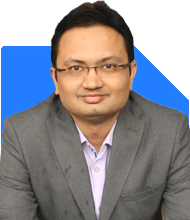Ramalingam Kalirajan |10881 Answers |Ask -Follow
Mutual Funds, Financial Planning Expert - Answered on Oct 25, 2024
He has an MBA in finance from the University of Madras and is a certified financial planner.
He is the director and chief financial planner at Holistic Investment, a Chennai-based firm that offers financial planning and wealth management advice.... more

Hello sir, I want to invest 8000 in MF as SIP for next 17 years, I want to invest with 50:30:20 ratio. Kindly suggest me the best MF to invest in large, mid and small cap Is it ok if I invest in grow app or shall I look for AMC
Large caps are well-established companies with strong market positions. They usually offer steady returns and are less volatile.
Mid-caps are companies that have potential for growth. While they may be more volatile than large caps, they can offer higher returns over time.
Small caps are companies in the early growth stage. They have the potential for high returns, but they come with higher risks due to market fluctuations.
Fund Selection
Here’s a framework you can use to pick the right mutual funds in each category. Avoid focusing on any single scheme. Instead, evaluate based on:
Performance: Look for funds that have consistently outperformed their benchmarks over the last 5 to 10 years. Avoid funds with short-term spikes in performance.
Expense Ratio: Choose funds with lower expense ratios. A high expense ratio can eat into your returns.
Fund Manager Experience: Check the experience of the fund manager. A seasoned fund manager usually navigates market volatility better.
Portfolio Diversification: Ensure the fund has a well-diversified portfolio across sectors and stocks.
Large-Cap Funds (50%)
You should focus on large-cap funds that invest in the top 100 companies. These companies are less volatile, and the funds offer relatively stable returns over the long term. These funds generally help you in wealth preservation while also providing decent growth.
Mid-Cap Funds (30%)
For your mid-cap allocation, look for funds that focus on companies with a good track record but are still growing. Mid-caps have the potential to become large-cap companies, giving you a good balance of growth and risk.
Small-Cap Funds (20%)
Small-cap funds are for investors who can handle high volatility. These funds can deliver significant returns, but they also come with increased risk. Over 17 years, this volatility will smooth out, offering potentially high rewards.
SIP Benefits for Long-Term Goals
SIPs (Systematic Investment Plans) work best when invested over a long period, such as your 17-year goal. Rupee cost averaging is one of the key benefits, where you invest a fixed amount every month, which helps you average out the cost of your investments, irrespective of market ups and downs.
SIP also inculcates discipline. You won’t need to time the market, which is beneficial for long-term wealth creation.
Active Funds vs. Index Funds
You may have heard about index funds, which simply track market indices like the Nifty or Sensex. While index funds might have lower expense ratios, they lack the flexibility that actively managed funds provide.
Index funds only mirror the market, meaning they do not provide opportunities for outperformance. They are not equipped to adjust to market conditions, which can limit your returns.
Actively managed funds give the fund manager the flexibility to adjust the portfolio. A skilled manager can take advantage of market inefficiencies, potentially delivering higher returns.
Therefore, it’s advisable to stick to actively managed funds where professional fund managers can make tactical decisions that may boost your returns.
Direct Funds vs. Regular Funds
Direct funds might seem attractive because they have lower expense ratios compared to regular funds. However, with direct funds, you lose out on professional advice. This can be detrimental, especially when navigating market volatility or selecting the best funds.
Investing through a Certified Financial Planner (CFP) or Mutual Fund Distributor (MFD) can add immense value. A CFP can help you select funds that align with your financial goals, risk profile, and market conditions. They will also assist you in rebalancing your portfolio periodically.
In the long run, the cost difference between regular and direct funds is minimal compared to the value of professional advice.
Taxation Considerations
When selling mutual funds, it’s important to be aware of the capital gains tax:
Long-Term Capital Gains (LTCG) for equity mutual funds: Gains above Rs 1.25 lakh are taxed at 12.5%.
Short-Term Capital Gains (STCG) for equity mutual funds: Gains are taxed at 20%.
For Debt Mutual Funds, both LTCG and STCG are taxed as per your income tax slab.
Make sure to factor in these taxes when planning your withdrawals. Keeping track of the holding period can help optimize your tax outgo.
Is Grow App Safe?
You asked about whether it’s okay to invest through apps like Grow or if you should go directly through the AMC (Asset Management Company). While apps like Grow, Zerodha, and Kuvera have made mutual fund investing more accessible, it’s important to weigh the pros and cons.
Pros of Apps: Convenience and ease of use. You can monitor your portfolio from anywhere, set up SIPs, and make changes with just a few clicks.
Cons of Apps: They may lack the personalized advice that comes from working with a Certified Financial Planner. The guidance offered by these platforms may be generic.
On the other hand, investing through an AMC directly or with the help of a CFP ensures that you get professional guidance. This becomes even more important when making decisions about rebalancing, goal setting, and market corrections.
Tracking Your Portfolio
Since you are investing for 17 years, it's important to track your portfolio periodically—every 6 to 12 months. This allows you to rebalance your portfolio based on market conditions. For example, if one segment (large, mid, or small-cap) has outperformed or underperformed significantly, you may need to adjust your SIP allocations accordingly.
A CFP can help you with rebalancing and ensure that your portfolio remains aligned with your risk appetite and financial goals.
Risk Mitigation Strategy
While mutual funds are a great tool for wealth creation, it’s essential to have a strategy to manage risks. Here are a few steps you can follow:
Diversify Across Fund Categories: Don’t just stick to large, mid, and small caps. Explore debt funds, hybrid funds, or international funds for better diversification.
Emergency Fund: Before aggressively investing, ensure you have an emergency fund that covers at least 6 months of expenses. This prevents you from withdrawing your mutual fund investments prematurely during emergencies.
Periodic Review: Periodically review your risk profile and goals. A CFP can help you decide if you need to adjust your investment strategy based on any changes in your life, like marriage, kids, or job change.
Final Insights
Your plan to invest Rs 8,000 monthly through SIP for the next 17 years is commendable. It’s a good strategy that aligns with your long-term financial goals. The 50:30:20 allocation is a well-balanced approach. However, it’s important to stay committed, review periodically, and adjust if necessary.
While apps like Grow are convenient, working with a Certified Financial Planner offers tailored guidance that can prove beneficial, especially for long-term wealth creation. Active funds, managed by skilled professionals, are likely to outperform index funds over such a long horizon.
Stick to your strategy, stay disciplined, and enjoy the wealth compounding effect over the years.
Best Regards,
K. Ramalingam, MBA, CFP,
Chief Financial Planner,
www.holisticinvestment.in
https://www.youtube.com/@HolisticInvestment
Let's embark on this financial journey together.
You can reach me through my website mentioned below.
This platform has restrictions on sharing personal contact. Hope you understand.
Best Regards,
K. Ramalingam, MBA, CFP,
Chief Financial Planner,
www.holisticinvestment.in
You may like to see similar questions and answers below
Tejas Chokshi | Answer |Ask -Follow
Tax Expert - Answered on Jun 14, 2023
Tejas Chokshi | Answer |Ask -Follow
Tax Expert - Answered on Jun 23, 2023
Ramalingam Kalirajan |10881 Answers |Ask -Follow
Mutual Funds, Financial Planning Expert - Answered on May 21, 2024
Ramalingam Kalirajan |10881 Answers |Ask -Follow
Mutual Funds, Financial Planning Expert - Answered on Oct 24, 2024
Ramalingam Kalirajan |10881 Answers |Ask -Follow
Mutual Funds, Financial Planning Expert - Answered on Jan 20, 2025
Nayagam P P |10854 Answers |Ask -Follow
Career Counsellor - Answered on Dec 14, 2025
Radheshyam Zanwar |6744 Answers |Ask -Follow
MHT-CET, IIT-JEE, NEET-UG Expert - Answered on Dec 14, 2025
Radheshyam Zanwar |6744 Answers |Ask -Follow
MHT-CET, IIT-JEE, NEET-UG Expert - Answered on Dec 14, 2025
Dr Dipankar Dutta |1840 Answers |Ask -Follow
Tech Careers and Skill Development Expert - Answered on Dec 14, 2025
Dr Dipankar Dutta |1840 Answers |Ask -Follow
Tech Careers and Skill Development Expert - Answered on Dec 13, 2025
Dr Dipankar Dutta |1840 Answers |Ask -Follow
Tech Careers and Skill Development Expert - Answered on Dec 13, 2025
Mayank Chandel |2575 Answers |Ask -Follow
IIT-JEE, NEET-UG, SAT, CLAT, CA, CS Exam Expert - Answered on Dec 13, 2025
Radheshyam Zanwar |6744 Answers |Ask -Follow
MHT-CET, IIT-JEE, NEET-UG Expert - Answered on Dec 13, 2025
Mayank Chandel |2575 Answers |Ask -Follow
IIT-JEE, NEET-UG, SAT, CLAT, CA, CS Exam Expert - Answered on Dec 13, 2025
Mayank Chandel |2575 Answers |Ask -Follow
IIT-JEE, NEET-UG, SAT, CLAT, CA, CS Exam Expert - Answered on Dec 13, 2025


























